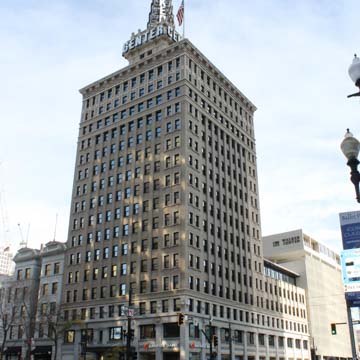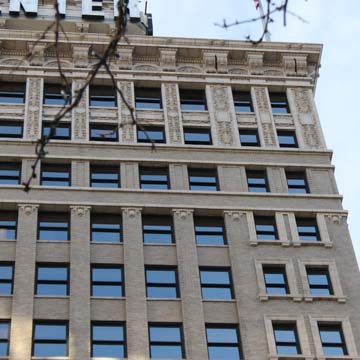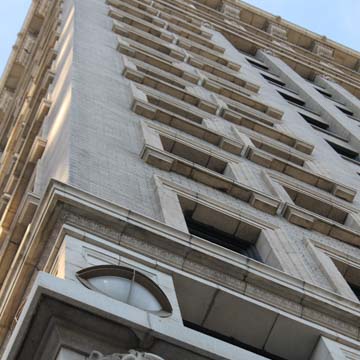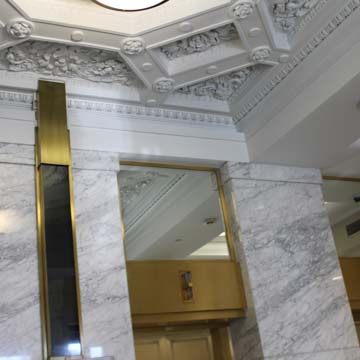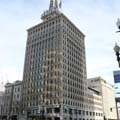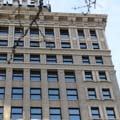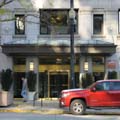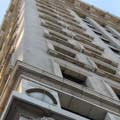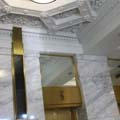You are here
Walker Center
Between 1911 and 1912, the residents of Salt Lake City witnessed the Walker Bank Building rising to 225 feet on the corner of 200 South and Main Street. The four Walker brothers had first arrived Salt Lake City in 1852 and soon launched a successful dry goods business, which also offered banking services; in 1859 the brothers established one of the first banks in the American West. This high-rise structure, located across Main Street from the Walker Dry Goods building, was a testament to their business acumen and success. It became the city’s tallest building at the time of its completion (eclipsing the recently built Boston and Newhouse buildings) and one of the tallest in the American West.
St. Louis–based architectural firm Eames and Young designed the sixteen-story building in a tripartite composition: at the base is the bank and retail storefronts, clad in cream-colored granite and featuring large, plate-glass windows; offices comprise the tan brick shaft; and the capital consists of the top two stories, with accentuated belt courses, arches, and modillions that support a wide cornice and naturalistic granite and terracotta ornamentation. Inset from the main tower atop the building is a smaller three-story tower that contains an elevator shaft, observation platform, and illuminated signage. The transition from the grand scale of granite at the base to the more delicate proportions of the upper brick stories and terracotta ornamentation is subtle. The decorative detailing, which includes lion heads and vegetal forms, is primarily vertically oriented, and draws the eye upwards. The composition is clearly aimed at giving the immense mass a sense of lightness, alluding to the steel frame beneath the masonry cladding. The delicately proportioned cornice also contributes to the sense of lightness; egg-and-dart detailing is repeated above the brackets and arches, running underneath the cornice and around the upper edges of the brackets. The cornice and the decorative panels wrap around the corners of the rear east and north elevations; the rest of the rear elevations are unornamented.
Originally the first level of the principal facade was somewhat asymmetrical, with a metal canopy above the ground story that wrapped around the building. The lobby was reached through a grand entryway in the center of the Main Street facade. The northernmost bay, marked with fluted Doric columns, led to the Walker Bank, while a smaller and simpler entrance in the southernmost bay provided access to a drug store. The bank and the lobby were identified by names carved in granite above the respective entrances. A 1956 remodel gave the facade its current symmetry: a metal canopy now shelters only the principal entrance, and the secondary bank entrance on the south was removed. Despite the entrance modifications, the exterior retains much of the original detailing. The interior, however, has undergone extensive changes, particularly during the 1956 remodel. Remaining original features include a section of decorative plaster ceiling in the elevator lobby, a functional mail chute, some door hardware, and marble treads on the stairs. The most recent renovations occurred in 2006. Though this remodel returned the entrance lobby to its original two-story height, it offers none of the original spaciousness.
The illuminated signage atop the building was originally “Walker Bank” in a single row of letters on each side of the three-story tower. In the 1930s, larger signs with “Walker” atop “Bank” replaced the earlier version. In 1947, the bank added a 90-foot radio tower that was used by the radio and television station KDYL—the first television station in Utah. When the station moved a few years later, vertical letters spelling “Walker” were added to each of the radio tower’s sides, with “Bank” written horizontally around the three-story tower’s roofline. At this time, the radio tower became a weather beacon, with the neon letters displaying blue for clear skies, flashing blue for cloudy skies, red for rain, and flashing red for snow. The radio tower was torn down after the building’s sale in 1983.
Now under new ownership, the renamed Walker Center maintains its connection to the Walker brothers, who formed an important chapter of Utah’s banking and mercantile history. The illuminated signage, reflecting this new name, was replaced in 2008, a couple years after the building was listed on the National Register of Historic Places.
References
Writing Credits
If SAH Archipedia has been useful to you, please consider supporting it.
SAH Archipedia tells the story of the United States through its buildings, landscapes, and cities. This freely available resource empowers the public with authoritative knowledge that deepens their understanding and appreciation of the built environment. But the Society of Architectural Historians, which created SAH Archipedia with University of Virginia Press, needs your support to maintain the high-caliber research, writing, photography, cartography, editing, design, and programming that make SAH Archipedia a trusted online resource available to all who value the history of place, heritage tourism, and learning.














